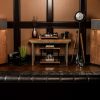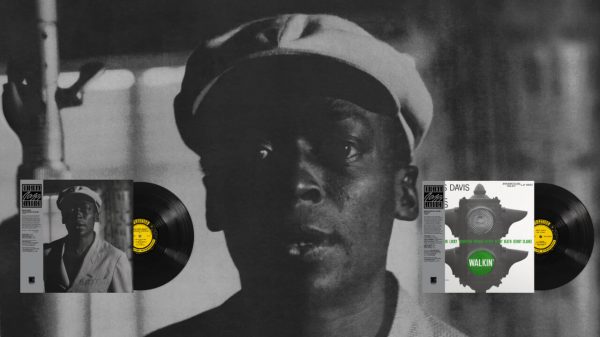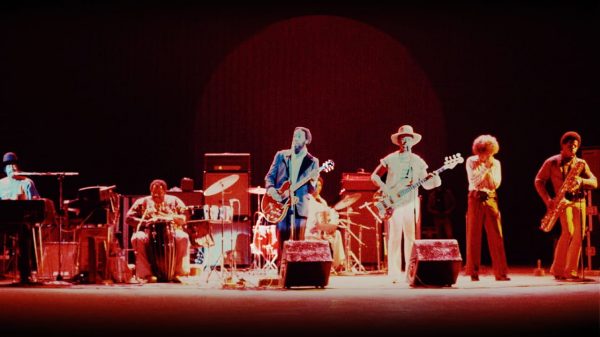Craft Recordings is celebrating the centennial of Eddie “Lockjaw” Davis with a brand-new, four-album collection, featuring the tenor saxophonist’s incendiary 1958 Cookbook albums with organist Shirley Scott. Set for release on February 3, 2023 in 180-gram vinyl 4-LP, 4-CD, and digital configurations, Cookin’ with Jaws and the Queen: The Legendary Prestige Cookbook Albums compiles four classic soul-jazz albums: Cookbook, Vol. 1, Cookbook, Vol. 2, Cookbook, Vol. 3, and Smokin’, all of which were recorded in stereo by the celebrated engineer, Rudy Van Gelder.
Available for pre-order, Cookin’ with Jaws and the Queen has been newly remastered from the original analog tapes by the GRAMMY-winning engineer, Bernie Grundman. Produced by Nick Phillips, the all-analog 4-LP edition (limited to 5,000 copies worldwide) is pressed on 180-gram vinyl at RTI, while each LP is individually housed in a tip-on jacket, featuring the original Prestige Records album artwork.

The 4-CD and digital editions feature three bonus tracks that were recorded in the 1958 sessions but didn’t appear on the original LP releases: “Avalon,” “Willow Weep For Me,” and an alternate take of “But Beautiful.” Rounding out the vinyl and CD packages is a deluxe booklet featuring recording session photos and offering new, in-depth liner notes by jazz journalist Willard Jenkins, who serves as the artistic director for the DC Jazzfest.
When tenor saxophonist Eddie “Lockjaw” Davis and Hammond B-3 organist Shirley Scott entered Rudy Van Gelder’s hallowed Hackensack, NJ studio in 1958, it was clear that something special was about to take place. For roughly three years, Scott and Davis had been at the forefront of the soul-jazz sound, setting the gold standard for the tenor sax/organ combo.
At 36, “Lockjaw” (also known as “Jaws”), was already a veteran of the New York City jazz scene, having spent much of the 1940s playing in the bands of Lucky Millinder, Andy Kirk, and Cootie Williams. But the horn player was also a stylistic chameleon, who straddled the line between the classic big band era and the emerging sounds of hard bop.
24-year-old Shirley Scott, meanwhile, was a rising talent from Philadelphia, who stood out as one of the few female musicians in the male-dominated world of jazz. Scott, who would soon become known as the “Queen of the Organ,” formed a creative partnership with Davis in 1955, and made her earliest recordings alongside the horn player.
By 1958, they were a well-oiled duo. In his liner notes, Jenkins underscores this magical pairing with a quote from saxophonist James Carter: “Every successful artistic partnership has members that truly work together in simpatico towards a common goal, which in this case is groovin’ and swingin’ their listening audience beyond good health! [Scott] never fails…to provide the perfect underpinning for Lockjaw to either soar above or to dig into to achieve the ultimate goal of a great musical encounter every time.
Lockjaw really listens to Shirley and takes his cues particularly on ballads, but she’ll put some gentle, intense fire under him on up tempos and inspire the best out of Lockjaw.” Jenkins adds, “This is classic Black vernacular jazz.”
Accompanying Davis and Scott in the studio was multi-reedist Jerome Richardson, who played the flute, baritone sax, and tenor sax. Bassist George Duvivier and drummer Arthur Edgehill rounded out the talented lineup. The sessions, which took place on June 20th, September 12th, and December 5th, 1958, were captured by a 34-year-old Rudy Van Gelder at his Hackensack studio, while Prestige Records’ Bob Weinstock and Esmond Edwards served as producers.

The repertoire that comprises four albums’ worth of material is a delicious combination of Davis-Scott originals and jazz standards. The Eddie “Lockjaw” Davis Cookbook, Vol. 1, originally released in June 1958, features several highlights, including the bluesy radio hit, “In the Kitchen.” Clocking in at just under 13 minutes, the mid-tempo, Johnny Hodges-penned track offers plenty of time for each musician to showcase their talents. Ballad “But Beautiful,” is another standout track which, Jenkins notes, is bolstered by “Lockjaw’s opulently expressive tone…[and] his beautifully legato, conversational solo.” Scott’s solo, he adds, is “soul personified in the keys.”
The momentum continues with The Eddie “Lockjaw” Davis Cookbook, Vol. 2, released in December 1958, which features interpretations of the Hoagy Carmichael-Mitchell Parish standard, “Stardust,” as well as originals like “Skillet” and opener “The Rev.” The latter piece, as the title conveys, features an expressive, conversational delivery between the musicians, as if between a preacher and his parishioners.
Cookbook, Vol. 3, which dropped in 1960, features such highlights as the George and Ira Gershwin classic, “Strike Up the Band,” the Shirley Scott original “The Goose Hangs High,” and the reflective “My Old Flame,” which Jenkins remarks, “elicits the kind of wistful posture from Jaws that one might expect from the lament of a love lost, befitting its title. Ms. Scott enters as if embodying that lost love’s farewell—‘See ya later, baby.’”
The collection concludes with Smokin’, an album that is also culled from the 1958 sessions but was originally released in 1964. The confident set finds the group jamming on originals like “Smoke This,” “High Fry,” and the self-titled “Jaws,” as well as such classics as Johnny Burke-Arthur Johnston’s “Pennies from Heaven,” Edgar Sampson’s “Blue Lou,” and the George Forrest-Robert Wight tune, “It’s a Blue World.”
The latter two tracks, Jenkins notes, exemplify Davis’ unorthodox approach to balladry. “Jaws consistently displays a slightly vigorous attitude towards ballads, rarely actually luxuriating in the moment. His balladic immersion is more that of someone who’s got places to go, people to see, food to cook; nonetheless his reverence for a good ballad is no less than his peers, it’s just that he constantly sounds ready for a more purposeful stroll rather than a casual linger.”
Davis and Scott certainly did have plenty to accomplish, following these phenomenal sessions. The two musicians would continue to collaborate through the end of the decade, recording such albums as Jaws in Orbit and Bacalao (both released in 1959), as well as Misty (1963).
Yet, despite the popularity of their work together, the artists went their separate ways, with Davis moving away entirely from the organ/tenor sound that he and Scott made famous.
Scott soon joined forces with her husband, tenor saxophonist Stanley Turrentine, and recorded dozens of sessions as a leader during her lengthy career. Davis, meanwhile, would continue to toe the line between small group soul-jazz and the classic sounds of big bands, working with the likes of Count Basie, Kenny Clarke, Gene Ammons, and Johnny Griffin—with whom he’d record multiple “Tough Tenors” albums.
But those five years that Davis and Scott worked together were instrumental in shaping the sound of soul-jazz—and these four delectable albums endure as some of their best work.
Click here to pre-order or pre-save Cookin’ with Jaws and the Queen: The Legendary Prestige Cookbook Albums now and head to CraftRecordings.com for exclusive Prestige Records merchandise.
















































